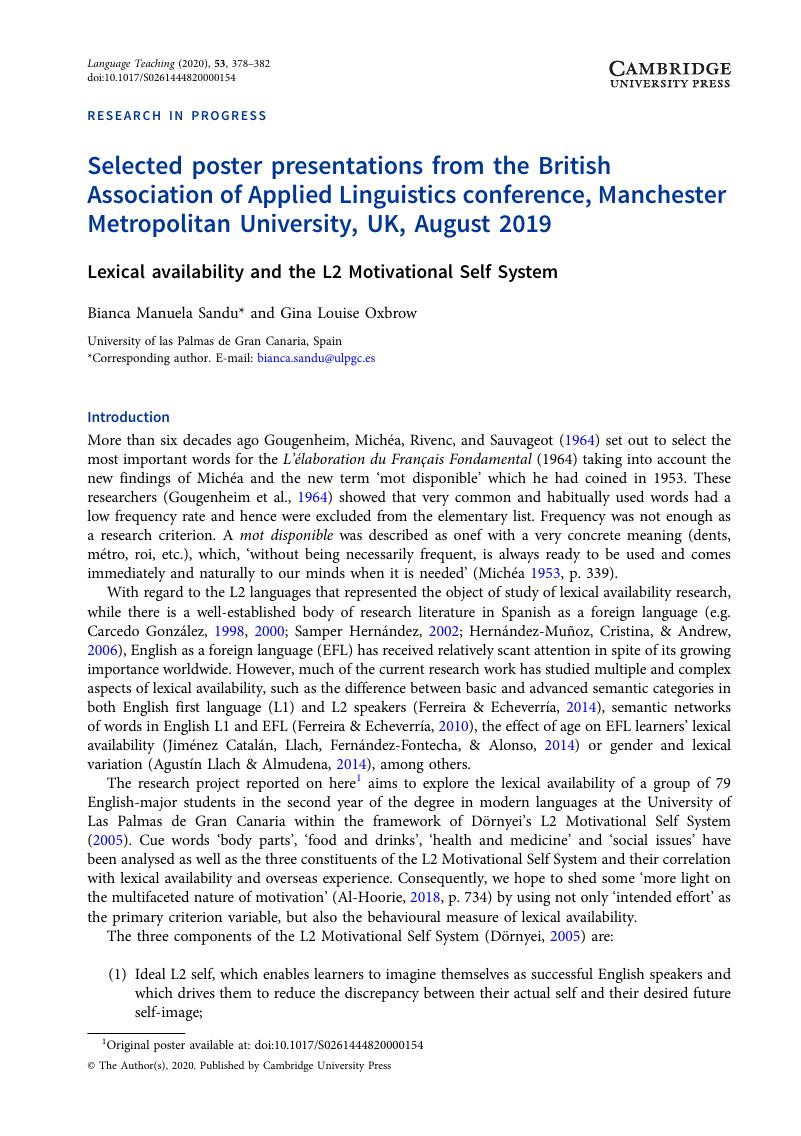No CrossRef data available.
Article contents
Selected poster presentations from the British Association of Applied Linguistics conference, Manchester Metropolitan University, UK, August 2019
Lexical availability and the L2 Motivational Self System
Published online by Cambridge University Press: 21 May 2020
Abstract
An abstract is not available for this content so a preview has been provided. Please use the Get access link above for information on how to access this content.

- Type
- Research in Progress
- Information
- Copyright
- Copyright © The Author(s), 2020. Published by Cambridge University Press
References
Agustín Llach, M. P., & Almudena, F. F. (2014). Lexical variation in learners’ responses to cue words: The effect of gender. In Jiménez Catalán, R. M. (Ed.), Lexical availability in English and Spanish as a second language (pp. 69–81). Heidelberg, Germany: Springer.CrossRefGoogle Scholar
Al-Hoorie, A. H. (2018). The L2 motivational self aystem: a meta-analysis. Studies in Second Language Learning and Teaching, 8(4), 721–754.CrossRefGoogle Scholar
Carcedo González, A. (1998). Sobre disponibilidad léxica en estudiantes de español como lengua extranjera. RILCE, 14(2), 202–224.Google Scholar
Carcedo González, A. (2000). Disponibilidad léxica en Inglés como lengua extranjera. El caso finlandés. Turku, Finland: University of Turku.Google Scholar
Csizér, K., & Kormos, J. (2009). Learning experiences, selves and motivated learning behavior: A comparative analysis of structural models for Hungarian secondary and university learners of English. In Dörnyei, Z., & Ushioda, E. (Eds.), Motivation, language identity and the L2 self (pp. 98–119). Bristol, UK: Multilingual Matters.CrossRefGoogle Scholar
Dörnyei, Z. (2005). The Psychology of the Language Learner: Individual Differences in Second Language Acquisition. London, UK: Lawrence Erlbaum.Google Scholar
Ferreira Campos, R., & Echeverría, M. S. (2010). Redes semánticas en el léxico disponible de inglés L1 e inglés LE. Onomazein, 21, 133–153.Google Scholar
Ferreira Campos, R., & Echeverría, M. S. (2014). Lexical availability of basic and advanced semantic categories in English L1 and English L2. Gender. In Jiménez Catalán, R. M. (Ed.), Lexical availability in English and Spanish as a second language (pp. 15–35). Heidelberg, Germany: Springer.CrossRefGoogle Scholar
Gougenheim, G., Miche´a, R., Rivenc, P., & Sauvageot, A. (1964). L’élaboration du français élémentaire. Paris, France: Didier.Google Scholar
Hernández-Muñoz, N., Cristina, I., & Andrew, W. E. (2006). Cognitive aspects of lexical availability. European Journal of Cognitive Psychology, 18(5), 730–755.CrossRefGoogle Scholar
Jiménez Catalán, R. M., Llach, M. P. A., Fernández-Fontecha, A., & Alonso, A. C. (2014). The effect of age on EFL learners’ lexical availability: Word responses to the cue words ‘town’ and ‘countryside’. In Jiménez Catalán, R. M. (Ed.), Lexical availability in English and Spanish as a second language (pp. 37–51). Heidelberg, Germany: Springer.CrossRefGoogle Scholar
Michéa, R. (1953). Mots frequents et mots disponibles. Un aspect nouveau de la statistique du langage. Les langues modernes, 47, 338–344.Google Scholar
Samper Hernández, M. (2002). Disponibilidad léxica en alumnos de español como lengua extranjera. Colección Monografías 4. Málaga, Spain: ASELE.Google Scholar
You, C. J., Zoltán, D., & Kata, C. (2016). Motivation, vision, and gender: a survey of learners of English in China. Language Learning, 66(1), 94–123.CrossRefGoogle Scholar




